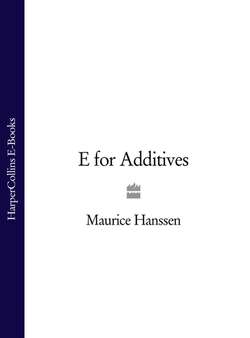Читать книгу E for Additives - Maurice Hanssen - Страница 16
Alcoholic Drinks
ОглавлениеAny drink with an alcoholic strength by volume of more than 1.2 per cent does not have to list the ingredients. This means that if you are, for example an asthmatic and are particularly sensitive to sulphur dioxide (E220), which is a commonly used preservative in wines, beers and ciders, then you have no way of telling whether it is present or not, let alone whether the content is near the permitted maximum or very low. If you are sensitive then you have to look out for the whole range of sulphites—E220 to 227—but when the Dutch Consumer Organization tested a selection of wines in 1985, they found that some of them had higher than the permitted limits of sulphur dioxide.
A test published in Which? magazine in May 1986 found that a number of the nineteen wines tested were near the maximum and that, if you regularly drank just a quarter litre (2 glasses) of most of the white wines, or one third of a litre (2 1/2 glasses) of some of the reds, you could exceed the Acceptable Daily Intake.
The EEC permits aeration, which is usually done with carbon dioxide (E290), to make cheap sparkling ‘bubbly’. To encourage the growth of yeasts during fermentation there is permission for an addition of diammonium phosphate or ammonium sulphate (no E numbers) up to a level of 0.3g/l either separately or combined. You can also feed the yeast by the addition of thiamin hydrochloride (vitamin B,) up to 0.6mg/l.
The sulphites that may be used include not only sulphur dioxide but also potassium bisulphite and potassium metabisulphite. White wines can be treated during fermentation with charcoal to a maximum of 100g of dry charcoal per hectolitre to remove impurities.
Wine has to be clarified, or cleared, after fermentation. However, some of the ingredients and processing aids that might be used provide significant moral problems for certain sections of the population who surely have the right to know if such items are being included in the process. The full list is:
—edible gelatines (made from bones)
—isinglass (made from the swim-bladders of fish)
—casein and potassium caseinate (milk proteins)
—animal albumin (egg albumin and dried blood powder)
—bentonite (clay) (558)
—silicon dioxide as a gel or colloidal solution (551)
—kaolin (a clay) (559)
—tannin (from wood)
—pectinolytic enzymes.
The use of sorbic acid (E200) or potassium sorbate (E202) is permitted. This stops the growth of yeasts and moulds. The final sorbic acid content of the treated product on its release to the market for human consumption must not exceed 200mg/l.
Tartaric acid (E334) for acidification purposes is permitted, but if there is too much acid, the following may be added under certain conditions:
—neutral potassium tartrate (E336)
—potassium bicarbonate (no E number)
—calcium carbonate (E170) which may contain small quantities of the double calcium salt of L(+)tartaric (E334) and L( – )malic acids (296).
The addition of Aleppo pine resin is permitted, the purpose being to turn wine into retsina, the typical Greek wine.
L-ascorbic acid (E300) can be added up to 150mg/l and as well as the vitamin C, citric acid can be added for wine stabilization provided that the final content does not exceed lg/1.
Potassium ferrocyanide (536) can be added to white and rosé wines, as can zinc sulphate heptahydrate (which does not seem to appear on the permitted list) which are used together for ‘blue finings’. Red wines can also use calcium phytate (no E number) with up to 100mg/1 of metatartaric acid (E353).
Gum acacia (E414) is another permitted additive. DL tartaric acid (E334) precipitates excess calcium, and ion and cation exchange resins can be employed in certain conditions.
Some countries permit the use of discs of pure paraffin impregnated with allyl isothiocyanate (no E number) to create a sterile atmosphere in containers holding more than 20 litres, but there may not be any trace of allyl isothiocyanate in the wine.
Potassium bitartrate (no E number) can be used to assist the precipitation of tartar. The wine can also be treated with up to 20mg/l of copper sulphate (no E number), provided that the copper content in the treated product does not exceed lmg/1.
So you see that there is more to wine than the simple product of the fermentation of grape juice.
